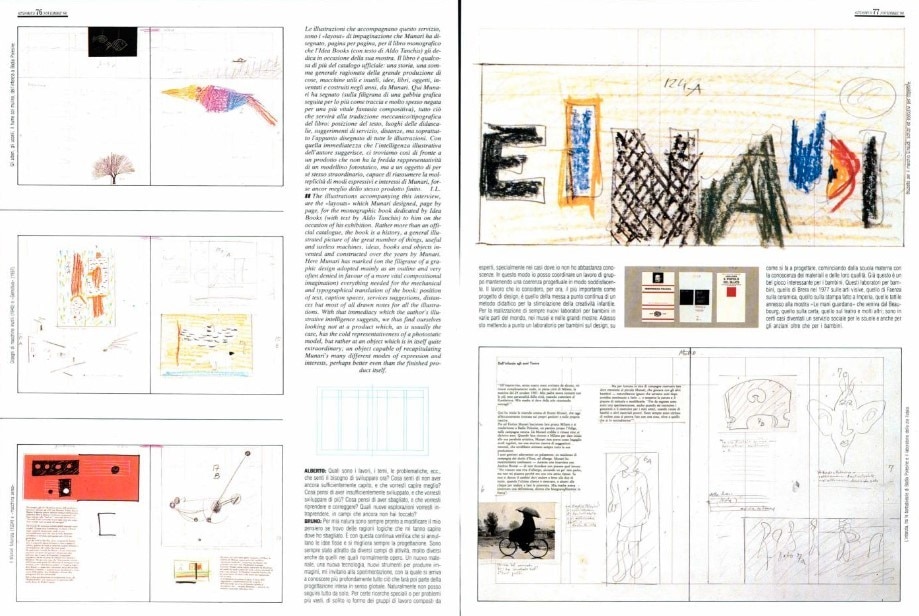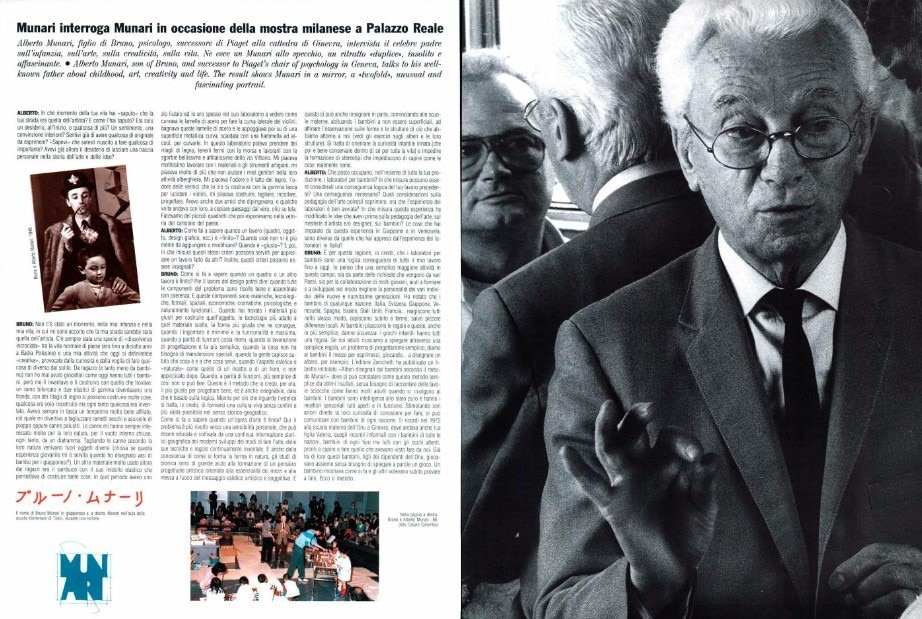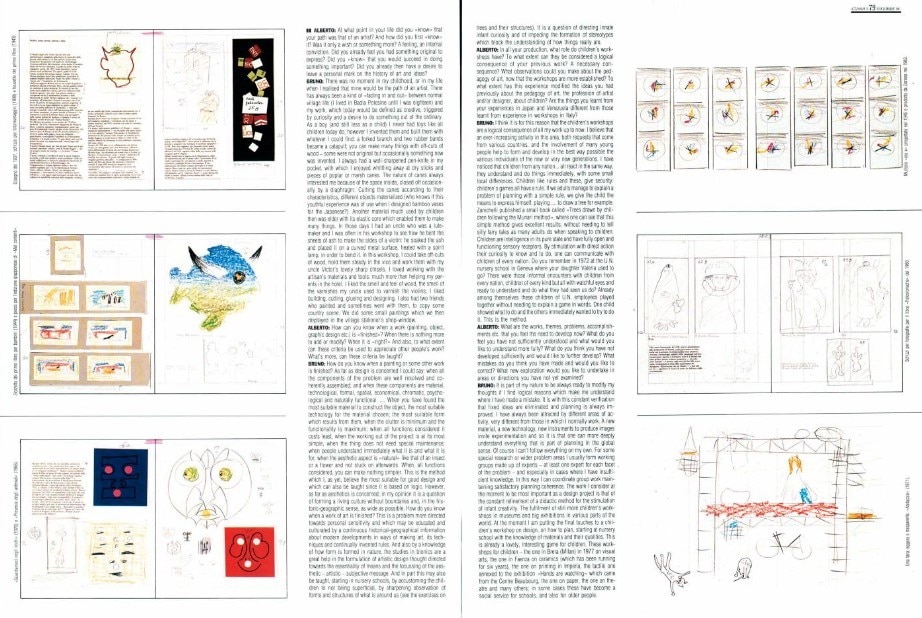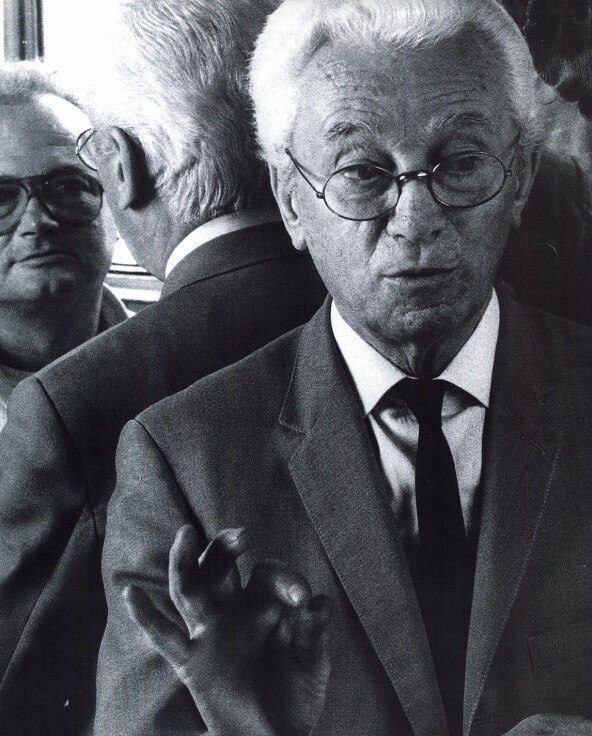“Art shall not be separated from life: things that are good to look at, and bad to be used, should not exist”: such an apparently obvious statement – actually a clear and non-majoritarian stance on art, utility, aesthetics and existence - is enough to illuminate all the depth necessary to produce simple, light-hearted works such as those by Bruno Munari. A major exhibition is dedicated in 2024 in Parma, to the artist, designer, graphic, inventor – art director at Domus in 1943-44 – but already in 1986 the importance of his action and his thought had been celebrated with an exhibition at the Palazzo Reale in Milan. For Domus it had been an opportunity to host – on issue 677 in April – a dialogue between Munari and his son Alberto where, among the drawings of milestones such as the Abitacolo structure, or the graphics and layout for Einaudi publisher, the reasons for making art as enriching life with imagination were outlined.

Munari questions Munari on the occasion of the Milan exhibition at Palazzo Reale
Alberto Munari, son of Bruno, and successor to Piaget’s chair of psychology in Geneva, talks to his well-known father about childhood, art, creativity and life. The result shows Munari in a mirror, a “twofold”, unusual and fascinating portrait.
Alberto Munari: At what point in your life did you “know” that your path was that of an artist? And how did you first “know” it? Was it only a wish or something more? A feeling, an internal conviction. Did you already feel you had something original to express? Did you “know” that you would succeed in doing something important? Did you already then have a desire to leave a personal mark on the history of art and ideas?
Bruno Munari: There was no moment in my childhood, or in my life when I realised that mine would be the path of an artist. There has always been a kind of “fading in and out” between normal village life (I lived in Badia Polesine until I was eighteen) and my work, which today would be defined as creative, triggered by curiosity and a desire to do something out of the ordinary. As a boy (and still less as a child) I never had toys like all children today do; however I invented them and built them with whatever I could find: a forked branch and two rubber bands became a catapult; you can make many things with off-cuts of wood - some were not original but occasionally something new was invented, I always had a well-sharpened pen-knife in my pocket, with which I enjoyed whittling away at dry sticks and pieces of poplar or marsh canes. The nature of canes always interested me because of the space inside, closed off occasionally by a diaphragm. Cutting the canes according to their characteristics, different objects materialized (who knows if this youthful experience was of use when I designed bamboo vases for the Japanese?), Another material much used by children then was elder with its elastic core which enabled them to make many things. In those days I had an uncle who was a lutemaker and I was often in his workshop to see how he bent the sheets of ash to make the sides of a violin: he soaked the ash and placed it on a curved metal surface, heated with a spirit lamp, in order to bend it. In this workshop, I could take off-cuts of wood, hold them steady in the vice and work them with my uncle Victor’s lovely sharp chisels. I loved working with the artisan’s materials and tools: much more than helping my parents in the hotel. I liked the smell and feel of wood, the smell of the varnishes my uncle used to varnish the violins; I liked building, cutting, glueing and designing. I also had two friends who painted and sometimes went with them, to copy some country scene. We did some small paintings which we then displayed in the village stationer’s shop-window.
How can you know when a work (painting, object, graphic design etc.) is “finished”? When there is nothing more to add or modify? When it is “right”? And also, to what extent can these criteria be used to appreciate other people's work? What’s more, can these criteria be taught?
How do you know when a painting or some other work is finished? As far as design is concerned I could say: when all the components of the problem are well resolved and coherently assembled; and when these components are material, technological, formal, spatial, economical, chromatic, psychological and naturally functional When you have found the most suitable material to construct the object, the most suitable technology for the material chosen; the most suitable form which results from them, when the clutter is minimum and the functionality is maximum; when all functions considered it costs least, when the working out of the project is at its most simple, when the thing does not need special maintenance; when people understand immediately what it is and what it is for, when the aesthetic aspect is “natural” like that of an insect or a flower and not stuck on afterwards. When, all functions considered, you can make nothing simpler. This is the method which I, as yet, believe the most suitable for good design and which can also be taught since it is based on logic. However, as far as aesthetics is concerned, in my opinion it is a question of forming a living culture without boundaries and, in the historic-geographic sense, as wide as possible.
How do you know when a work of art is finished? This is a problem more directed towards personal sensitivity and which may be educated and culturated by a continuous historical-geographical information about modern developments in ways of making art, its techniques and continually invented rules. And also by a knowledge of how form is formed in nature, the studies in bionics are a great help in the formulation of artistic design thought directed towards the essentiality of means and the focussing of the aesthetic - artistic - subjective message. And in part this may also be taught, starting in nursery schools, by accustoming the children to not being superficial, by sharpening observation of forms and structures of what is around us (see the exercises on trees and their structures). It is a question of directing innate infant curiosity and of impeding the formation of stereotypes which block the understanding of how things really are.

In all your production, what role do children’s workshops have? To what extent can they be considered a logical consequence of your previous work? A necessary consequence? What observations could you make about the pedagogy of art, now that the workshops are more established? To what extent has this experience modified the ideas you had previously about the pedagogy of art, the profession of artist and/or designer, about children? Are the things you learnt from your experiences in Japan and Venezuela different from those learnt from experience in workshops in Italy?
I think it is for this reason that the children’s workshops are a logical consequence of all my work up to now. I believe that an ever-increasing activity in this area, both requests that come from various countries, and the involvement of many young people help to form and develop in the best way possible the various individuals of the new or very new generations. I have noticed that children from any nation... all react in the same way, they understand and do things immediately, with some small local differences. Children like rules and these, give security: children’s games all have a rule. If we adults manage to explain a problem of planning with a simple rule, we give the child the means to express himself, playing.... to draw a tree for example.
Zanichelli published a small book called “Trees drawn by children following the Munari method”, where one can see that this simple method gives excellent results, without needing to tell silly fairy tales as many adults do when speaking to children. Children are intelligence in its pure state and have fully open and functioning sensory receptors. By stimulation with direct action their curiosity to know and to do, one can communicate with children of every nation. Do you remember in 1972 at the U.N. nursery school in Geneva where your daughter Valeria used to go? There were those informal encounters with children from every nation, children of every kind but all with watchful eyes and ready to understand and do what they had seen us do? Already among themselves these children of U.N. employees played together without needing to explain a game in words. One child showed what to do and the others immediately wanted to try to do it. This is the method.

What are the works, themes, problems, accomplishments etc. that you feel the need to develop now? What do you feel you have not sufficiently understood and what would you like to understand more fully? What do you think you have not developed sufficiently and would like to further develop? What mistakes do you think you have made and would you like to correct? What new exploration would you like to undertake in areas or directions you have not yet examined?
It is part of my nature to be always ready to modify my thoughts if I find logical reasons which make me understand where I have made a mistake. It is with this constant verification that fixed ideas are eliminated and planning is always improved. I have always been attracted by different areas of activity, very different from those in which I normally work. A new material, a new technology, new instruments to produce images invite experimentation and so it is that one can more deeply understand everything that is part of planning in the global sense. Of course I can’t follow everything on my own. For some special research or wider problem areas I usually form working groups made up of experts - at least one expert for each facet . of the problem - and especially in cases where I have insufficient knowledge. In this way I can coordinate group work maintaining satisfactory planning coherence. The work I consider at the moment to be most important as a design project is that of the constant refinement of a didactic method for the stimulation of infant creativity. The fulfilment of still more children's workshops in museums and big exhibitions in various parts of the world. At the moment I am putting the final touches to a children’s workshop on design, on how to plan, starting at nursery school with the knowledge of materials and their qualities. This is already a lovely, interesting game for children. These workshops for children - the one in Brera (Milan) in 1977 on visual arts, the one in Faenza on ceramics (which has been running for six years), the one on printing in Imperia, the tactile one annexed to the exhibition “Hands are watching” which came from the Centre Beaubourg, the one on paper, the one on theatre and many others; in some cases these have become a social service for schools, and also for older people.


